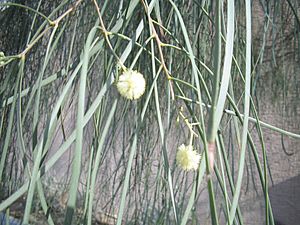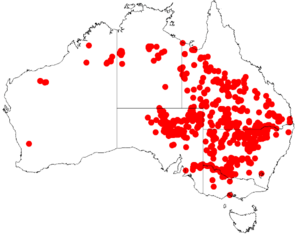Acacia stenophylla facts for kids
Quick facts for kids Acacia stenophylla |
|
|---|---|
 |
|
| Scientific classification | |
| Genus: |
Acacia
|
| Species: |
stenophylla
|
 |
|
| Occurrence data from AVH | |
| Synonyms | |
Acacia stenophylla is a type of tree often called the shoestring acacia. It's an evergreen tree, meaning it stays green all year round. This tree belongs to the Fabaceae family, which includes peas and beans. You can find it growing naturally in Australia. It's not a rare or endangered plant, so there are plenty of them around!
Contents
What Does the Shoestring Acacia Look Like?
The shoestring acacia, or Acacia stenophylla, can look different depending on where it grows. It might be a round, bushy shrub with many stems, or a tall, spreading tree. These trees can grow from 4 to 20 meters (about 13 to 65 feet) tall. Often, their branches start about 1 meter (3 feet) up the trunk.
The bark of the tree is usually dark gray to black and feels rough. Its younger branches are smooth or slightly hairy.
Leaves and Flowers of the Shoestring Acacia
The "leaves" of this acacia are actually called phyllodes. They look like long straps, about 15 to 40 centimeters (6 to 16 inches) long and 2 to 10 millimeters (less than half an inch) wide. They can be straight or slightly curved. These phyllodes have many veins running closely together.
The flowers grow in small clusters called racemes. Each cluster has 3 to 5 flower heads. The flower heads are round, about 6 to 9 millimeters (a quarter to a third of an inch) across, and are creamy-white to pale yellow. Each flower has five parts. The tree often flowers in autumn, but it can bloom at other times too.
Pods and Seeds of the Shoestring Acacia
After flowering, the tree produces pods that look like a string of beads (this is called moniliform). These pods can be up to 26 centimeters (10 inches) long and 8 to 12 millimeters (about half an inch) wide. They feel woody and leathery.
Inside the pods are dark brown, oval-shaped seeds, each about 7 to 9 millimeters (a third of an inch) long. The seeds don't have a special fleshy covering (called an aril), but the stalk that connects them to the pod (the funicle) is enlarged and folded.
How Tough is This Tree?
Acacia stenophylla is a very tough tree! It can handle a lot of salt, which means it can grow in salty soils. It's also pretty good at surviving frost and long dry periods (drought). On average, it needs at least 400 millimeters (about 16 inches) of rain each year to grow well.
Where Does the Shoestring Acacia Grow?
You'll mostly find Acacia stenophylla in central and eastern Australia. It's also sometimes seen in the dry areas of Western Australia, but it's much rarer there.
This tree grows from the Murray River in South Australia and Victoria, all the way up to western New South Wales, the Northern Territory, and Queensland. A small number of them are also found in Western Australia. It usually grows in places that are 50 to 325 meters (about 160 to 1060 feet) above sea level.
How Does the Shoestring Acacia Live in Nature?
Climate Conditions for the Shoestring Acacia
The shoestring acacia usually lives in warm, dry climates. It grows biggest in semi-dry areas, like parts of New South Wales and Queensland. It can also be found in slightly more humid (moist) areas of Queensland.
In most places where it grows, the hottest month has average temperatures of 35–38 °C (95–100 °F). The coolest month has average temperatures of 4–7 °C (39–45 °F). It often experiences 1 to 20 heavy frosts each year. This tree can also handle different amounts of rainfall, especially if there's extra water from groundwater or occasional floods.
Where It Likes to Grow: Land and Soil
Acacia stenophylla is common in the flat, low-lying parts of Australia. You'll often see it on flat lands and gentle slopes. It loves to grow along the banks of rivers, on river floodplains, and in dips in the land. The soil it prefers is usually fine and made of alluvium (silt, sand, or clay deposited by flowing water). It also likes red sandy clay and gray cracking clays. These soils often have a high pH (meaning they are alkaline) and can be salty deeper down.
Other Plants That Grow with It
The shoestring acacia often grows in long, thin lines along waterways. It's usually part of open forests or woodlands where Eucalyptus trees are common. You might find it growing in the undergrowth with other acacia species like Acacia salicina and Acacia pendula. It can also grow alongside Eucalyptus populnea and Casuarina cristata. However, in semi-dry areas, it often grows by itself along rivers.
How People and Animals Use the Shoestring Acacia
Cattle don't usually eat Acacia stenophylla, but sheep find it tasty. Indigenous Australians used to roast the seeds and pods of this tree and eat them.
The plant is also thought to contain natural compounds that might have medicinal uses.
Because it can handle dry conditions and looks nice, Acacia stenophylla is often planted in gardens and public areas, especially in places like the Southwestern United States and California. It's a popular ornamental tree for its beauty and toughness.
How Does the Shoestring Acacia Reproduce?
Acacia stenophylla usually flowers from March to August, but it can flower at other times too. Its seed pods become woody as they ripen, usually from October to December. Each gram of seeds can contain about 6 to 12 seeds that can grow into new plants.
The seeds of Acacia stenophylla sprout very easily. After big floods, you can often see many young seedlings growing along the flood line. However, only a small number of these young plants survive to become mature trees.
How Is the Shoestring Acacia Classified?
Acacia stenophylla belongs to the Acacia group, which has about 1200 different types of species around the world. About 900 of these species are found only in Australia.
Here's how scientists classify it:
- Kingdom: Plantae (Plants)
- Phylum: Charophyta
- Class: Equisetopsida
- Subclass: Magnoliidae
- Superorder: Rosanae
- Order: Fabales
- Family: Fabaceae (Pea family)
- Genus: Acacia
- Species: Acacia stenophylla
What Are Its Other Names?
In Australia, Acacia stenophylla has many common names, including:
- Balkura
- Belalie
- Black Wattle
- Dalby Myall
- Dalby Wattle
- Dunthy
- Eumong
- Gooralee
- Gurley
- Ironwood
- Munumula
- Native Willow
- River Cooba
- River Myall
Where Did Its Name Come From?
The scientific name stenophylla comes from two ancient Greek words: stenos, which means "narrow," and phyllon, which means "leaf." So, Acacia stenophylla literally means "acacia with narrow leaves," which perfectly describes its strap-like phyllodes!
Gallery
Images for kids
-
A. stenophylla – Macquarie Marshes
-
A. stenophylla – with seed pods (just south of Moree)






